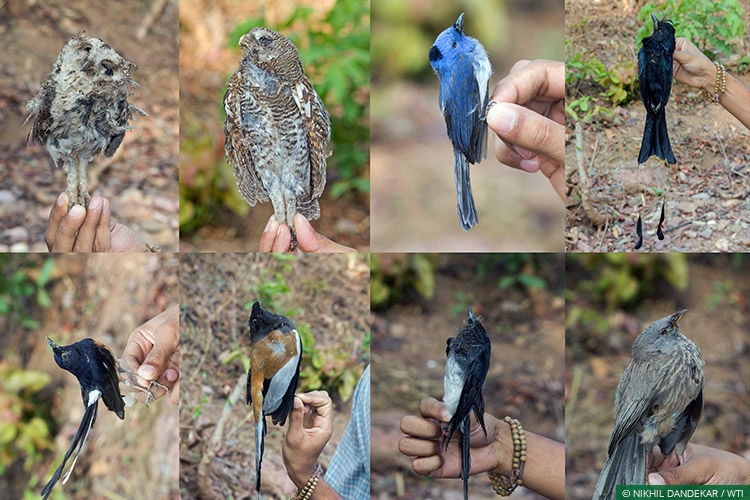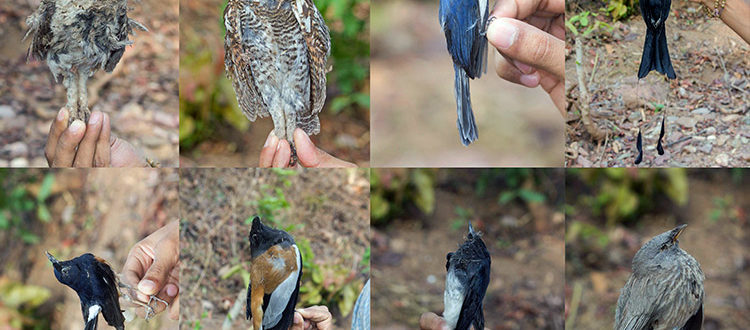The Mystery of the 40 Dead Birds
By Nikhil Dandekar
“Jitu, gaadi rok!” I shouted in excitement, asking my colleague to stop the car. A flutter of activity on the left had caught my eye. It was a drongo, a bird that is always interesting to watch – it can mimic the calls of other species and is very bold in driving away predators. Several smaller bird species keep company with such protectors.
Even before the car stopped, I had spotted an Orange-headed thrush (Geokichla citrina), a pair of Indian pittas (Pitta brachyura), a White-rumped shama (Copsychus malabaricus) and a pair of Monarch flycatchers hanging out with three drongo species. It was a scenario made for birding but, since I only had a Canon 55-250mm lens with me, not ideal for photography. I was reluctant to get out of the car but Anil, Jaydeep and Jitu were already out, so I followed suit.

We had started a bit late that morning. Driving through villages in the Navegaon-Nagzira Wildlife Corridor, from Sadak Arjuni to Dalli to Sahakepar, conducting meetings with villagers (all in a day’s work at Wildlife Trust of India’s Vidarbha Tiger Project), we had finally reached the highway. It was blocked due to an accident so we decided to take a detour towards Shenda. It was a hot afternoon in the peak of summer, we were bored, and only an exciting wildlife sighting would reinvigorate us.
We entered a patch of woodland, sparse trees and light undergrowth, but it made us feel more at home. There was a large cement saucer filled with water on one side of the road and on the other, a small cave on a shaded rocky slope. That’s when I spotted the drongo and had Jitu stop the car.
As I scanned the area with my binoculars one particular bird caught my eye: a White-bellied drongo (Dicrurus caerulescens). To my shock, I saw that it was lying dead on the slope just below the cave. It was in perfect condition, its body undamaged, not eaten. “It must have died due to heat stroke”, I said to myself.
It was lying some 15 feet off the ground and we couldn’t reach it, so we decided to continue with our birdwatching. Seeing a pair of White-rumped shamas so close was a treat. Indian pittas were calling continuously and Jungle babblers (Turdoides striata), as usual, were noisy. There were Greater racket-tailed drongos (Dicrurus paradiseus) trying to catch flies and Oriental white-eyes (Zosterops palpebrosus) moving swiftly from branch to branch.
“Sir, ek aur hai”, I heard Jitu calling: ‘there’s another one’. I went to the spot and found another dead White-bellied drongo. Now I was really confused. Two dead birds in perfectly good condition, could this be really heat stroke? As a keen birdwatcher I know that drongos are usually first on the scene to catch escaping insects during a forest fire. But before I had any more time to think Jaydeep called out: he had found two more drongos. Then, I found two dead Black-naped monarch flycatchers (Hypothymis azurea). This was becoming impossible to comprehend. We decided to sweep the area.
My heart was not ready to believe what my eyes were looking at. Birds that we would otherwise travel miles to see, to photograph, were lying dead in front of me.
It soon felt like playing the card game of Challenge: “Ek aur, ek aur, ek aur” (one more, one more, one more), the dead birds were piling up. When we were done, we collected the birds on a flat rock. There were 40 in all; 13 species including three drongo species, Monarch flycatchers, Rufous treepies (Dendrocitta vagabunda), Magpie robins (Copsychus saularis), Jungle babblers, White-throated kingfishers (Halcyon smyrnensis), Common hawk-cuckoos (Hierococcyx varius), Red-vented bulbuls, one White-rumped shama, a Jungle owlet (Glaucidium radiatum) and six Indian scops owls (Otus bakkamoena). All specimens seemed completely undamaged.
My heart was not ready to believe what my eyes were looking at. Birds that we would otherwise travel miles to see, to photograph, were lying dead in front of me. It was also the first time I had held a dead bird in my hands. I couldn’t hold back my tears.
“Nikhil, what should we do about them?” Anil’s question brought me back to reality. We decided to document the incident properly and started photographing each species. We also recorded the burnt undergrowth in the area and checked the water in cement saucer, which we found to be in good condition. Finally, our minds in overdrive and our hearts heavy, we decided to leave.
‘Expect the unexpected’ is kind of our unofficial motto when we venture out into the forest. But this, certainly, was not the unexpected that we had expected.
What happened out there, in that sparse woodland? We still don’t know. It remains ‘The Mystery of the 40 Dead Birds’.
The author is a field biologist with Wildlife Trust of India’s Vidarbha Tiger Project









